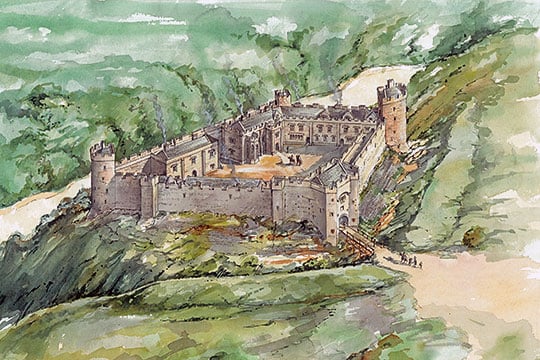History of Berry Pomeroy Castle
Berry Pomeroy is unusual among English castles in that its history has only recently been established. Once thought to be of Norman origin, the castle was in fact begun during the later 15th century by the Pomeroy family. Within its defences, the Seymour family built a modest early Elizabethan mansion, and from about 1600 they extended this on a palatial scale, intending to create a great house to rival Longleat or Audley End. But their overambitious project suddenly foundered for lack of funds, and by 1700 the castle was an abandoned shell.

The Medieval Pomeroy Fortress
When the Pomeroy family began to build Berry Pomeroy Castle in the later 15th century, they had already owned the manor of ‘Berri’ for over 400 years. It had originally been granted by William the Conqueror to Ralf de Pomaria, a Norman knight from La Pommeraye near Falaise. There is, however, no record of an earlier fortress here. The Pomeroys previously occupied an unfortified manor house by the village church, which was still in full use in 1496.
Archaeology has established that the castle was built on a previously unused site over a mile north-east of the village church, within an existing deer park. Exactly when the castle was begun remains uncertain. It first appears in the records when Sir Richard Pomeroy died in 1496 as owner of the ‘honour, castle and manor of Bury’.[1]
The castle’s founder may have been Henry Pomeroy, who owned Berry Pomeroy from 1461 until 1487, or his heir, Sir Richard Pomeroy. Its foundation (or perhaps completion) by Sir Richard is made more likely by the fact that broadly similar artillery defences were being constructed at nearby Dartmouth Castle during the 1480s, and by the very late 15th-century wall-painting in the castle gatehouse.
The Pomeroys’ motive for building the castle was all but certainly the disturbed state of Devon, then the most lawless area of southern England.[2] Local feuds, escalating from 1455 into the conflict later known as the ‘Wars of the Roses’, involved the Pomeroys on the ‘Yorkist’ side. The strength of Berry Pomeroy’s up-to-date fortifications leaves no doubt that it was designed for serious defence.
The Elizabethan Mansion
Though the outer defences of the late 15th-century Pomeroy fortress remain imposing, the medieval buildings within were swept away during the building of the Elizabethan mansion or ‘courtyard house’.
In December 1547, Berry Pomeroy was bought from the impoverished Sir Thomas Pomeroy by the wealthy and powerful Edward Seymour, Duke of Somerset (c 1500–1552). Seymour was the brother of Henry VIII’s third and favourite queen, Jane Seymour, and in 1547 became ‘Lord Protector’ of his nine-year-old nephew, King Edward VI, and thus effectively ruler of England.
The Berry Pomeroy estate was Somerset’s most valuable single acquisition, but it was only one of the many properties he gathered during his rise to power. His reputation as the patron of ambitious mansions once gave rise to the unfounded belief that he also undertook extensive building works at Berry Pomeroy. Yet he may never even have visited, and certainly his ownership was short-lived: he was executed in January 1552.
According to the Seymour family biographer, ‘the first of this honourable family that settled in Devon’[3] was the Protector’s eldest surviving son by his first marriage, Edward, Lord Seymour (1529–93). This Lord Seymour built the Elizabethan courtyard house.
Because there were doubts about his legitimacy, however, the ‘junior’ branch of the Seymour family (descendants of the Protector by his second wife) enjoyed their principal lands and titles, while the ‘senior’ Berry Pomeroy branch was sidelined. This situation was clearly a constant source of annoyance to the Berry Pomeroy Seymours: their ambitious later building programme here may indeed have been prompted by a desire to score off the ‘junior’ branch of the family.
Lord Seymour probably began his mansion within the medieval castle walls in the early 1560s, perhaps at about the time of his summons to attend Queen Elizabeth I’s court in 1562.
An east range (infilling the fourth side of the inner courtyard) had been added by about 1590. Though comparatively modest in size, it was of advanced design for the time, compact and very tall, and with two complete floors of accommodation above two more containing the hall and services.
‘A very stately house:’ Extensions
During the first decade of the 17th century, work began on transforming Lord Seymour’s mansion into ‘a very stately house’,[4] comparable with the great contemporary houses being built elsewhere in England.
This was the work of Lord Seymour’s son, Edward Seymour II (about 1563–1613), who inherited Berry Pomeroy in 1593. Immense in scale and ambition, the project involved not only the replacement of the old house’s north range by a grand staircase and galleries, leading to luxurious new rooms in the east range, but also the raising of a stupendous new north wing, three storeys high.
It is not clear why Edward Seymour wanted to undertake such extravagant building works, on a rather cramped and unsuitable site, nor how he intended to fund them; in any event, building came to an abrupt halt.
By June 1611 he was certainly in serious financial trouble, though only a month later he made a last contribution to his family’s fragile status by purchasing a baronetcy. So it was as Sir Edward Seymour, first baronet, of Berry Pomeroy, that he died in April 1613, with his great house unfinished, never to be completed.
FIND OUT MORE ABOUT EDWARD SEYMOUR II AND HIS UNFINISHED MANSION
Retrenchment
Neither Sir Edward Seymour III, second baronet (about 1572–1659), nor his son Sir Edward IV (1610–88), generally known as ‘Colonel Edward’, made any attempt to complete their predecessor’s ambitious works. Indeed an inventory of 1688 shows that the family retreated into an updated version of the old Elizabethan mansion.[5]
Though both Sir Edwards were enthusiastic Royalists during the Civil War, the castle itself was never garrisoned or attacked. But it was only by adroit manoeuvring, and the help of the Colonel’s beloved and formidable wife, Anne, that Berry Pomeroy was kept out of government hands during the Commonwealth, whereafter Sir Edward’s loyalty was highly honoured by Charles II at the Restoration. The old cavalier dispensed famous hospitality at Berry to all comers, and continued in government service well into his seventies.
Abandonment and Demolition
In 1697 John Prince lamented that Berry Pomeroy Castle was ‘now demolished, and … buried in its own ruins; there being nothing standing but a few broken Walls’.[6]
This demolition was deliberately carried out by the new owner, Sir Edward IV’s son Sir Edward Seymour V (1633–1708). Known as Speaker Seymour from his tenure of that Parliamentary office in 1673, he had quarrelled bitterly with both his parents as a young man, and his political concerns were in London.
Timber beams were removed whole; flagstone floors lifted; lead and tiles stripped from roofs; glass torn from windows, their leading being melted down;[7] and decorated stonework was removed.
The castle remained the property of the Seymour baronets (by then permanently settled at Maiden Bradley in Wiltshire), who in 1750 at last succeeded to the family title of Duke of Somerset. It is still owned by the present duke, a direct descendant of the Berry Pomeroy Seymours.
Romantic Ruin and New Discoveries
In the late 18th century, the supremely picturesque ruins of Berry Pomeroy became a magnet for artists and sightseers. The development of nearby Torquay and later Paignton as holiday resorts brought even more visitors to marvel at the ‘aweful’ ruins and speculate about their supposedly sinister history.
Imaginations were inflamed by novels like The Castle of Berry Pomeroy, a ‘Gothic’ tale of jealousy, multiple murder and ghostly revenge first published in 1806 and re-issued among a spate of late Victorian romantic novels set in what was then thought to be a Norman castle. Even today, perhaps unfortunately, Berry Pomeroy is promoted as ‘the most haunted castle in Devon’.
READ MORE ABOUT BERRY POMEROY CASTLE
About the author
Charles Kightly is the author of the English Heritage Red Guide to Berry Pomeroy Castle.
Footnotes
1. Calendar of Inquisitions Post Mortem: Henry VII, vol 1 (1898), 514, 516–17.
2. RL Storey, The End of the House of Lancaster (London, 1966), 84–92, 165–75.
3. J Prince, Worthies of Devon, new edn (London, 1810).
4. T Risdon, Survey of the County of Devon (London, 1811).
5. Devon Record Office, Accession 3799M–3.
6. Prince, op cit.
7. S Brown (ed), ‘Berry Pomeroy Castle’, Devon Archaeological Society Proceedings, 54 (1996 for 1998), 153.
FIND OUT MORE



